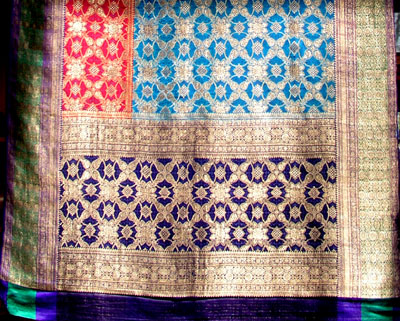The only textile from India that Jean and I own is a spectacular sari from Benares. It's 15 feet long, 4 feet wide, so photographing the whole thing is out of the question. It's also full of gold thread, which makes photographing it difficult because of the high reflectivity of that part.
Anyway, with those apologies as backdrop, here is one end of it:

The warp and weft colors differ (you can see the warp colors at the lower end of the image), and colors change as it moves. The camera can't capture that effect, but it is quite remarkable.
I don't know the age, but there are some small holes and edge fraying, and the silk has no trace of the stiffness that I associate with later textiles from mainland southeast Asia. One person who saw it said that she was sure that it's 19th century. Maybe it is, maybe not.
Lynton's book, The Sari mentions that use of gold (as opposed to gold-colored) thread was common in Benares saris until recently, and illustrates a corner that of a wedding sari that was saved as a memento when the owner incinerated the rest of it to recover the gold. So the thread in ours may actually be gold. Then again, maybe it isn't.
Regards
Steve Price